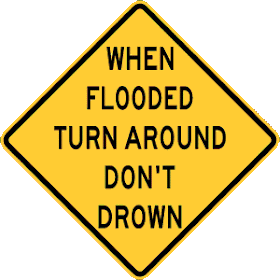ST. LOUIS (AP) - Christina Thompson was joking when she texted her dad last month after days of unrelenting thunderstorms near his rural southern Missouri home: "Are you getting washed away?"
She didn't realize that hours earlier, the 69-year-old retiree had been swept to his death as he tried to cross a flooded patch of road to get home. William Floyd's body was found five days later, still in his 2009 Kia Spectra, which was wedged onto a log with only its bumper and rear tires visible.
"Why would he do that?" Thompson asked of her father's ill-fated decision to drive through the water. "I was just wondering, 'What was he thinking?' My dad was smarter than that. It just didn't make sense."
Such tragedies are all too common. Despite public service announcements, warning signs, barriers and even gates at flood-prone crossings, the majority of flood deaths in America involve people trying to drive through water on flooded roads.
"It is frustrating," said Todd Shea, warning coordinator meteorologist for the National Weather Service in La Crosse, Wisconsin. "It gets back to human nature. Sometimes you look at these cases and you just have to shake your head."
 Data compiled by Shea shows that 595 Americans have died in floodwater since 2011. A few fell into rivers or drowned while fishing on flooded waterways. And some children died playing too close to high water. But 61 percent of victims died in vehicles, often after driving around barriers or ignoring signs warning them to turn back.
Data compiled by Shea shows that 595 Americans have died in floodwater since 2011. A few fell into rivers or drowned while fishing on flooded waterways. And some children died playing too close to high water. But 61 percent of victims died in vehicles, often after driving around barriers or ignoring signs warning them to turn back. Texas, with its vast rural areas and many waterways, has had more flood-related deaths than any other state since 2011. Nim Kidd, chief of the Texas Division of Emergency Management, said too many people underestimate the power of water and "think emergencies and disasters happen to somebody else."
When torrential rains in late April led to flooding across Missouri, five people, including Floyd, died driving onto flooded roads. The death toll would have been worse if not for hundreds of water rescues.
Among those rescues were nine calls in Joplin, the Missouri town devastated by a 2011 tornado that killed 153 people. Fire Chief Jim Furgerson said rescuers put their own lives on the line to save people in flooded cars.
"We take precautions with life vests, we have ropes, but you don't know if there's something hidden in the water that's going to cut you or catch your ankle," Furgerson said.
Kidd was involved in countless water rescues earlier in his career when he was a firefighter in San Antonio.
"We would ask people, 'Why did you drive around a barricade?' or, 'Why did you drive into the water?'" he said. "The number one answer was, 'I didn't know any other way to get to where I was going.' We've got to change that mindset."
Officials throughout the U.S. are trying. Several state agencies and the National Weather Service have produced public service announcement videos warning that just a foot of water can sweep away and car and 18-24 inches of water can do the same to a larger vehicle. Several states place "When Flooded Turn Around Don't Drown" warning signs provided by the weather service at flood-prone crossings.
Many cities and towns, including Joplin, have installed gates that block passage at flood-prone areas when the water rises. Missouri and other states use electronic highway billboards to warn drivers of dangerous areas. Flash flood alerts can be sent to cellphones.
Kim and Shea said they are hopeful technology will eventually go even further, such as phone alerts warning drivers they are approaching a flooded-out road.
Experts agree, though, that common sense must prevail.
Thompson still grapples with why her dad - a former Boeing worker and "master tinkerer" who could fix anything - opted to take back roads home from a wedding reception that night, driving down a steep gravel road into eventual disaster.
"When there's ice and snow, you stay home. Why is rain so different? A road is still impaired," she said. "It's important, too, that people understand: This doesn't happen very often, but we forget that it can happen. People underestimate it, and that's sad."






